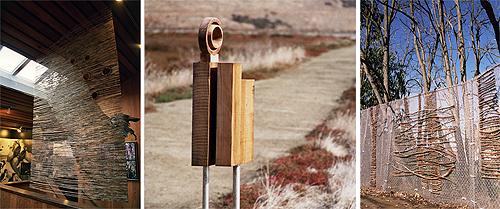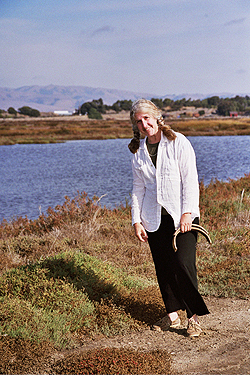Berkeleyan
 Grad student Molly McGrath harvested Spartina alterniflora, an invasive plant found in several locations at the edge of San Francisco Bay, to painstakingly fashion a hanging screen, left, for the visitor center of the Don Edwards San Francisco Bay National Wildlife Refuge. Outside the center, on the five-mile trail around the salt ponds, can be found Marie Sorenson's seven abstract, human-scale bird sculptures - one of which (center) represents the long-legged American avocet, a year-round refuge inhabitant. At East Oakland School of the Arts, Carla Dominguez is completing an ambitious master's thesis project: weaving a pattern of trees into a chain-link fence and bringing their imprint into the building itself, in the form of etchings on its concrete walls. (Joanne Connelly photos) |
When your client's a clapper rail
An 'architect in reverse' explores possibilities for farming the city and flooding the mall
![]()
| 02 December 2005
Architects (and architects in training) tend to have humans, not endangered avians, in mind as they imagine new structures (or their future careers in the field). So when "Architecture for the Birds" - an advanced design studio dedicated to "architecture that serves nature as its primary client" - appeared in the spring 2005 course listing, it was a bit of a hard sell to aspiring Andos and Calatravas in Wurster Hall.
 Associate Professor of Architecture Jill Stoner visits the salt-marsh trail at the Don Edwards San Francisco Bay National Wildlife Refuge, where works by her graduate students are now installed.(Joanne Connelly photo) |
At the refuge's visitor's center, just south of the Dumbarton Bridge, Marie Sorenson's seven abstract, human-scale bird sculptures (complemented by an interpretive booklet on the species represented and environmental threats to their survival) mark a five-mile loop trail along the edge of the salt ponds. In the center itself hangs a screen by Molly McGrath, who harvested the cordgrass Spartina alterniflora, a wetland invasive, and transformed it into a building material. Across the bay, a faithful map of the three Bair islands - superimposed with images of two endangered island denizens, the California clapper rail and the salt marsh harvest mouse - marks the surface of Toben Windahl's "Periodic Table."
'Biasing nature'
"What I asked them to do was extremely difficult," says Associate Professor of Architecture Jill Stoner, who designed and taught "Architecture for the Birds." Seldom are architecture students able to get permanent projects installed in the community within a 15-week semester. This time, students not only explored a site and developed a concept, but completed subsequent steps of real-world architectural practice (client sign-off, construction documents, code review, and installation) - all this in a setting "where building itself is considered the wrong thing," Stoner notes. "The nature preserve is about not building; it's about biasing nature in every way." Officials at the refuge had final say on the proposals, making for challenging and edifying negotiations, as students' plans were reviewed and sometimes sent back for revisions more sensitive to wildlife-management needs.
"Architecture for the Birds" is a recent expression of Stoner's long time interest in what she calls "putting architecture in reverse." It's her view, in a nutshell, that "we've overbuilt; we're not using what we've built very well; and we're pushing nature out."
This quarrel with misguided development is a not-uncommon one, richly explored by many critics, she's quick to note. "There are so many people doing that work well; the criticism is really good." (She cites as example Mike Davis' 1990 book City of Quartz, a history of the development of Los Angeles and, by extension, "an amazing critique of the capitalist landscape.") Stoner is disappointed, however, by some alternative proposals for living, and building, more lightly on the earth. The green-building movement, to her mind, reveals itself as self-contradictory when, for instance, building materials are trucked across the continent, burning fossil fuels all the way, as part of a "green" project.
While she's been known to decry "the currents of technology, of progress, of capitalism, of professionalism, and (aggressively) of new urbanism" in academic writing, Stoner finds it more gratifying to imagine alternatives through design (she heads the small San Francisco-based firm Stoner Meek), and to share her vision through teaching than to tender criticism. Thus, for the better part of her career, she has been proposing schemes for radically transforming big buildings (by subtracting floors and opening sections to the elements), reverting dying malls to wetlands, and turning desolate blocks of urban real estate into agricultural plots. In her design studios, she encourages students, as well, to "bias nature" in their own evolving practice.
Sorenson, though initially hesitant to take a design studio "for the birds," says she came to appreciate in the course of the semester that buildings are often designed "for their own aesthetic," tone-deaf to the world around them. In developing her bird-centric interpretive trail, she explored possibilities for raising people's awareness of their physical environment through design - a lesson she hopes to carry forward to other contexts. "Making a project in which a bird was the 'client,'" Sorenson says, "actually caused me to think more about the specific requirements a [more conventional] client might have for a building."
Imagining alternatives
Stoner and her professional partner, Susannah Meek, have garnered accolades for visionary schemes that weave nature back into the fabric of human environments. In 2003, their plan for reverting the dying Vallejo Plaza Mall back to the site's original wetland ecology - flooding some of its parking lots and selectively demolishing unoccupied retail area - was one of five winners of the international "Dead Malls" competition sponsored by the Los Angeles Forum for Architecture and Urban Design.
As far back as 1991, Stoner advocated "Farming Detroit" - a strategy for converting vacant blocks of the inner city, laid waste in the 1967 riots, to agricultural acreage, "effectively turning the traditional city inside-out," she says, by "surrounding an empty green center with urban density." The concept figures in "Rain in the City," an article to be anthologized next year by Routledge Press.
For San Francisco, where the post-war high-rises have had high vacancy rates since the dotcom bust in 2001, Stoner pictures tax credits for owners who convert some of their square footage, ideally the entire 20th floor, to open-air public space, removing the windows and letting the birds fly through. "The 20th floor is my obsession," she says. San Francisco's tall buildings were built to 20 stories prior to World War II, 40 stories after the war. The Stoner Meek offices were located for several years on the top floor of the pre-war Hobart Building, affording a view of the city that suggested this new kind of center for the city, one located in its vertical dimension.
When the Oakland Unified School District decided to divide troubled Castlemont High into four smaller schools, Stoner's firm won the contract to convert the former industrial-arts building into the new East Oakland School of the Arts (EOSA). Like her visions for high-rise buildings, the transformation relies largely on the strategy of subtraction, revealing materials and opening spaces to the outdoors so as to bring students closer to the natural world.
Literature being Stoner's other passion, she is working on a series of anthologies that collect literary inspirations for architecture. The first, Poems for Architects, was published by William Stout in 2001; a prose anthology, Stories for Architects, is due out in 2006. At EOSA she designed a series of windows etched with quotations chosen by the principal and teachers - each celebrating an artistic discipline within the school. In front of each window is a lectern with an open book, to inspire students to read even as they are moving between classes.
'In and with the elements'
Another design feature at the high school - one in tune with Stoner's interest in getting students to actively engage with the physical dimensions of the world outside the studio - is emerging just outside the building, where a grove of eucalyptus trees and a culverted creek, beyond a tall chain-link fence, inspired grad student Carla Dominguez to execute an ambitious thesis project. Under Stoner's mentorship, and recently with assistance from students at the high school, she is using harvested eucalyptus wood to weave the pattern of the trees onto the school side of the fence (see photo, bottom right) and bringing their imprint across the courtyard and into the building itself. The trees appear variously as etchings in concrete and as shadows over text stenciled onto the interior walls.
Bringing the creek "into the building," Stoner says, was her firm's initial concept for the EOSA design, executed architecturally via a concrete wall that "flows" through the main hall. She calls Dominguez's design "the perfect complement and completion of this agenda." It is also, she says, "a truly extraordinary labor of love, extending several months past the thesis semester, and moving into another dimension through the collaborative effort of the high-school students."
With the deeply satisfying EOSA project near completion (she calls it a nearly ideal example of "what I dream about: a true collaboration of clients, Berkeley students, nature, and cultural expression"), Stoner has plans to close her firm. "I'm exhausted by the indoor dimension of architectural practice, the amount of paperwork and phone calls," she says.
Once that chapter is closed, there may be opportunities to collaborate with her children (both in their 20s and involved in field ecology); she also wants to work "more directly in and with the elements, and more intensively with my Berkeley colleagues and students."
For starters, Stoner hopes to don mud boots with her students, to explore the South Bay ghost town of Drawbridge, whose historic buildings are sinking into the marsh. "I'd love to lead a studio in which we take a building down in a place like Drawbridge," she says, "carefully salvage and inventory the wood, and reconstitute it as nesting boxes for the peregrine falcon, in open air on the 20th floor of a San Francisco building."

